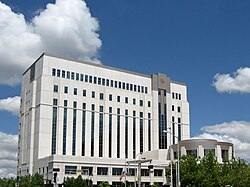Metropolitan Detention Center
Persons being held for trial at the Metropolitan Court, or convicted of misdemeanors and serving sentences under 12 months, are incarcerated in the county jail facility, the Metropolitan Detention Center (MDC), about 10 miles west of Albuquerque, on a rural mesa. The 500,000-square-foot (46,000 m2) campus employs around 500 staff, and houses over 2,000 inmates. Construction was completed in 2002, to replace the overcrowded, in-town county jail near the courthouse. It is the county’s largest public facility, and single greatest consumer of electricity, using, for example, 12,627,000 kilowatts in 2012, at a cost of $981,563. Use of solar power at the facility has increased, and as of January 2014, 20% of its power was provided by a 1-megawatt system of photovoltaic panels. [2]
This page is based on this
Wikipedia article Text is available under the
CC BY-SA 4.0 license; additional terms may apply.
Images, videos and audio are available under their respective licenses.
